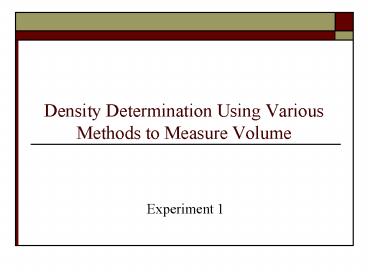Density Determination Using Various Methods to Measure Volume - PowerPoint PPT Presentation
1 / 27
Title:
Density Determination Using Various Methods to Measure Volume
Description:
1. Make pycnometer. 2. Calibrate. Calibration example ... trial masswater pycnometer. 1 92.7829 g. 2 92.7825 g. 3 92.7826 g. 4 92.7831 g. Average: 92.7828 g ... – PowerPoint PPT presentation
Number of Views:1154
Avg rating:3.0/5.0
Title: Density Determination Using Various Methods to Measure Volume
1
Density Determination Using Various Methods to
Measure Volume
- Experiment 1
2
Experiment 1
- Goal
- To accurately determine densities of objects
- Method
- Determine volume of objects (3 methods)
- Calculate densities from mass and volume
3
Densities
Increasing density Increasing heaviness
4
Density from lab data
? Analytical balance
? Three methods
- Volume measurements
- by geometry
- by water displacement
- by pycnometry
5
Uncertainties/Error
- Mass balance 0.0001 g
- Geometry calipers 1 of last digit cm
- Displacement grad. cylinder 0.1 mL probably
- Pycnometry pynometer from ?average?
- Propagate all but mass fractions
6
Procedure
- 1. Four cylinders
- brass aluminum plugged hollow
- Record
- 2. Number
- 3. Type type
- 4. Mass (analytical balance) m
7
1) Volume by geometry
- 1. Lengths and diameters l, d
- 2. Calculate volume and error V, sV
diameter, d
length, l
8
1) Al example density using volume by geometry
- Mass 17.4640 g
- Length 5.08 cm
- Diameter 1.29 cm
9
Using vernier calipers
Line on auxiliary scale matches at 8
Length 3.38 0.01 cm
Section 3B in manual
Object falls between 3.3 and 3.4 cm
10
2) Volume by water displacement
- 1. Record initial volume of water Vi
- 2. Add metal cylinder
- 3. Record final volume Vf
- 4. Calculate volume and error V, sV
11
2) Al example using volume by water displacement
- mass 17.4640 g
- Vwatercylinder 66.55 mL ?0.05mL
- ? Vwater 60.00 mL ?0.05mL
- Vcylinder 6.55 mL ?0.1mL
12
Water displacement
Meniscus liquids curved surface
66.0 mL
46.5 mL
66.0 mL 45.5 mL 20.5 mL (objects
volume)
13
3) Volume by pycnometry
- Pycnometry pertaining to specific gravity
- V mH2O/?H2O
- 1. Make pycnometer
- 2. Calibrate
14
Calibration example
- Calibration multiple trials (how well you fill
to the mark) - trial masswaterpycnometer
- 1 92.7829 g
- 2 92.7825 g
- 3 92.7826 g
- 4 92.7831 g
- Average 92.7828 g
- smass ?0.0003g (using big equation)
15
Pycnometry continued
- 3. Add H2O to mark
- record initial mass mi
- 4. Add metal cylinder
- 5. Remove H2O until at mark
- 6. Record final mass mf
- 7. Calculate volume and error V, sV
16
Pycnometry continued
A
B
17
3) Al example using volume by pycnometry
- massA 92.7828 g (calibration average) ?0.0003g
- massB 103.7227 g ?0.0003g
- masscylinder 17.4640 g ?0.0001g
18
Record temperature, T
19
4) Volume of void in hollow cylinder
pycnometry
20
Example void calculation brass cylinder
- If Vcylinder 4.970 mL (by pycnometry)
- mcylinder 34.5964 g (analytical balance)
- ?brass 8.387g/mL (pycnometry of
solid cylinder)
No error propagation required for this
21
5) Mass Fractions in Mixed Cylinder
Let mAl X.mcyl mbrass (1-X)mcyl
22
Mixed cylinder
m ?
V
mAl X.mcyl mbrass (1-X)mcyl
? by mcyl
Collect terms with X
Solve for X
? to isolate X
23
Mixed cylinder
Pycnometry volume Vmixed Balance mass
mmixed
X Al fraction 1-X brass fraction
No error propagation required for this
24
Mixed cylinder example
Use pycnometry data to find density of pure
brass 8.387 g/mL density of pure Al (solid
cylinders) 2.671 g/mL density of mixed cylinder
(example) 6.457 g/mL
X Al fraction (here 13.97) 1-X brass
fraction (here 86.03)
No error propagation required for this
25
Report
- Abstract
- Results/ Samples calculations including
- Mass and volume by each method
- Volume of void
- Mass fraction
- Error analysis (parts 1 4)
- Volume of objects (3 methods) yes
- Volume of inner void no
- Mass fractions for mixed cylinder no
- Discussion/review questions
26
Equipment
- cylinders brass, aluminum, mixed, hollow
- Vernier calipers
- 50 mL Erlenmeyer flask
- lab marker
- Pasteur pipet
- 100 mL graduated cylinder
- 400 mL beaker
- thermometer
- (analytical balance)
27
Caution
NO
YES































